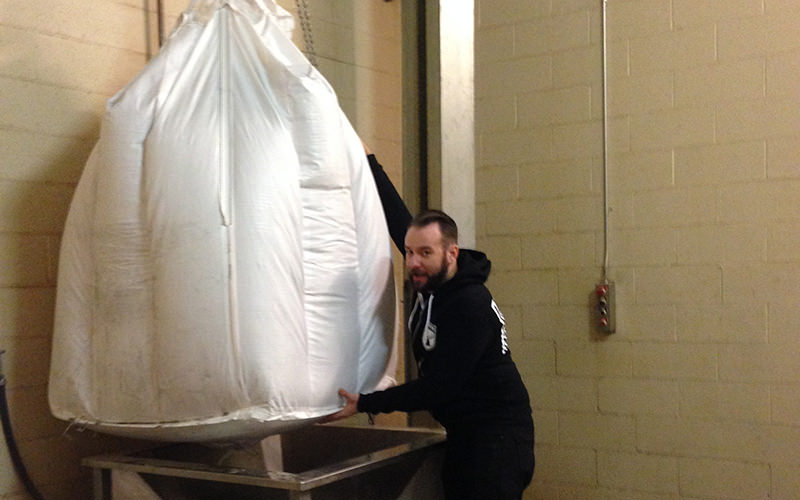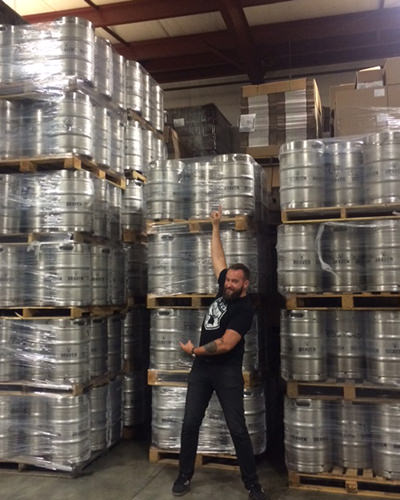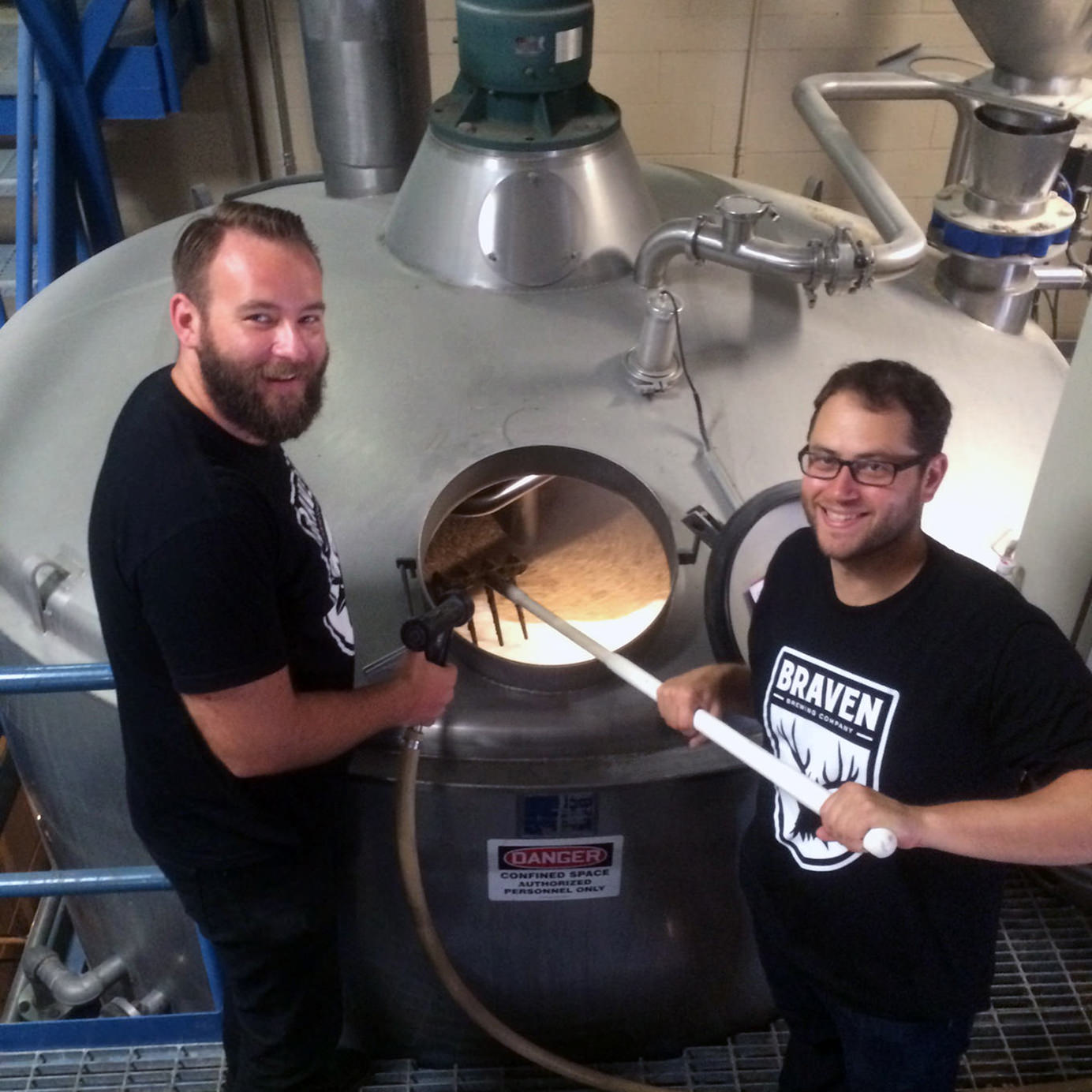Missed Part One? Read about Braven Brewing’s beginning here.
About two years ago, Braven Brewing was a brewery that was beginning to make a name for itself in craft beer circles. They had a logo, a website, even swag. And they had run a successful kickstarter campaign that had raised just enough money to keep the brand front and center. They were even becoming known for their killer parties. It’s safe to say that at least among those in-the-know New York craft beer fans, Braven was a presence. There was just one problem: they didn’t have any actual beer.
Apart from the beer Braven was still homebrewing and serving at small branded events, the mass production of these successful recipes was still something founders Eric Feldman and Marshall Thompson had not yet accomplished. Following the company’s successful kickstarter campaign they knew they were going to need more funds if they were going to open a Brewery. “ We wanted to be in Bushwick fast,” says Feldman “so we decided to file for a private placement, which is a securities offering that allows you to raise money from individuals who meet a certain set of criteria.” The thought was, if Braven could raise additional funds, they’d be able to procure a space in Bushwick and start brewing immediately.
“We figured we needed to just raise a small amount of money so that we could get a tiny system and figure out how the hell we would survive. Just get the system, get set up, and we’ll figure it out later. I think Marshall’s saying was, ‘Jump out of the plane and find a parachute on the way down,’ which was the plan,” Feldman recalled.
But soon after filing the private placement, the Braven founders pulled it. “It just wasn’t going to be right,” Feldman says. As they started looking around Bushwick for a space they also began to realize there were a lot more issues that they would have to contend with than they originally thought. “There were problems with every single space,” says Feldman. That was going to mean raising a lot more money than they expected to receive from the private placement, so the guys decided to regroup.

Neither Marshall nor Eric comes from a family with money, and neither was exiting a job where they had recently made millions, so they had to figure out how to make their brand a reality by considering every single option that was available to them. One option was simply good old-fashioned networking, and this turned out to reveal the path Braven would wind up taking in order to get its beer into the hands of the general public.
Sign up to be notified when we publish additional entries in the series, Building Braven Brewing.
“Marshall had been working as a bartender and he was getting to know a ton of different beer distributors. We started hanging out with them after hours, getting drinks as friends and telling everyone we could about Braven. During one such night, we were hanging out with some of the people from SKI, a highly respected craft beer distributor in the city – SKI represents brands such as Founders, Cigar City, Harpoon, and Bear Republic – and they became interested in what we were doing. They respected the brand and liked that we already had a following and support, even without brewing a single bottle of legally sellable beer. I also think they respected our hustle. So these employees introduced us to other SKI employees and eventually we worked our way into meeting the head of sales. We got along with him fantastically and he suggested we meet with the CEO and see what was possible.”
“SKI was interested,” says Feldman “but we didn’t have any actual beer we could sell, since we had no physical brewery space. Sort of out of the blue in the meeting, I just casually mentioned that we were going to contract brew – even though we had no idea how to do that or where – and all of a sudden everyone perks up and we’re told they’re going to give us a contract. It was pretty awesome.”
Contract brewing isn’t just as easy as pitching the idea in a meeting however, so now the guys had to find an actual brewer. “We reached out to Olde Saratoga, because SKI already had a relationship with them, and they said they could do a run of our White IPA for us,” says Feldman, “They brew for a bunch of other folks beer as well, so we knew if things worked out, we could keep producing with them.” The guys had never brewed any beer at a commercial brewery before, and the thought of doing so was pretty intimidating. “We were scared of them when we were talking to them, Olde Saratoga brews on a 120 barrel system. They brew double batches, so they brew about 210-220 barrels at a time. So we were going from 5 gallons to over 6,000 and we were horrified.”
To set up the contract brew, Braven had to agree to a barrelage amount for the year. “Saratoga wanted to make sure this wasn’t a one-off brew,” says Feldman. Braven agreed to set a target of 1,000 barrels and if they fell short, they’d be liable to Saratoga at a fee of $30 for every unbrewed barrel. After the contract was signed, both Marshall and Eric liquidated their savings accounts and scraped together just enough money in order to brew the first batch. “If the first batch didn’t sell, we’d be screwed,” says Feldman. “We didn’t have enough money to pay for our entire 1,000 barrel commitment, so we needed the first batch to sell out in order to pay for the second, and so on. If that didn’t happen, we’d both be completely broke.”
Then it was time to scale up the recipe. Eric sent Saratoga the 5 gallon homebrew recipe for Braven White IPA that he and Marshall had created in his kitchen and Saratoga scaled the proportions up to make them work on their system.
Braven brewed their first batch on December 10, 2014. “Marshall and I went up to be there for the brewing, it was a 100 barrel batch, which equals 200 kegs, we were thinking everything should go smoothly, but just before we started to brew, Saratoga warned us about the spices we wanted to use,” says Feldman.
“The White IPA has coriander and orange peel, but we were used to using these ingredients on the home-brew level. Saratoga warned us, the shit you have at home, its brew level is weak. It’s not going to be as good as fresh ground, as if you just got new peppercorns. So they warned us, you’ve got to scale your recipe down, if you use as much as you use at home, it’s going to taste terrible. So we said great, let’s cut it in half. So we cut it in half, brewed the first batch, and tried it at the end: the beer was undrinkable. It was super bitter, I wouldn’t want this in a million years, I don’t know what the hell is wrong with it, but something was wrong. Is it the hopping? Maybe the utilization is wrong. Maybe we put too much hops in it. But it’s a hopping beer, it’s an IPA. Maybe it’s the spices, we didn’t know.”

Eric and Marshall were at a complete loss of what to do, and scared about what the implications could be. “We set the samples down, and said we needed to take a walk,” says Feldman. “We’ve got to get the hell out of there, because we can’t make any decision right now without being totally spun up and scared about it – this was all our savings in this undrinkable beer. And at the same time they were already mashing in on the second batch. So Saratoga said, ‘You have about an hour to figure this out because in about an hour we’re going to start putting hops back in, and then we’re going to start to boil.”
Leaving the brewery to take a walk outside, Marshall and Eric realize they basically have an hour to save or sink the company. “After we walked around for a bit, we went back in and took another sip of the beer, at the same time Marshall and I say to each other, ‘it has to be the coriander, it’s just too much. So we make the decision, no spices at all in the second batch, then we’ll blend the two batches together and we’ll wind up with a quarter of the spices we intended. We just prayed it would work, but we wouldn’t get to find out for three weeks. So we pack up our car and head back to New York.”
The next three weeks were filled with anxiety for both Marshall and Eric, if the beer was undrinkable, they’d be finished and if they made a beer without the quintessential spices, it wouldn’t be a Braven White IPA. On December 30 Eric drove back up to Saratoga without Marshall to try the beer. “Saratoga puts one of the kegs on their draft line and they pour me a glass in their tasting room. I call Marshall so I can live taste the beer on the phone, still not knowing what to expect, and pretty scared to take a sip. When I finally did, it was brilliant, exactly like the beer we brewed in my kitchen. We were going to be ok.”
Now Braven just had to hope they’d be able to sell it…
Sign up to be notified when we publish additional entries in the series, Building Braven Brewing.
